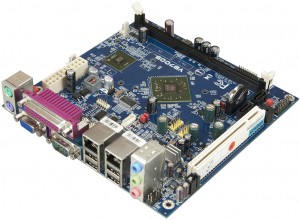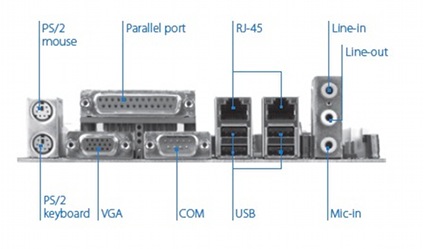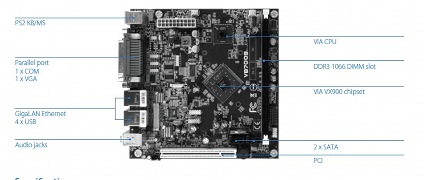Mini-ITX board has Via processors, powered serial ports
Jan 4, 2012 — by LinuxDevices Staff — from the LinuxDevices Archive — 44 viewsVia Technologies added to its range of Mini-ITX boards with a device “designed specifically for POS and kiosk applications.” The VB7009 supports up to 4GB of DDR3 memory, provides eight USB 2.0 ports and up to six powered serial ports, has two gigabit Ethernet ports, and offers a PCI expansion slot, according to the company.
 Via is a longtime champion of the 6.7 by 6.7-inch Mini-ITX motherboard form factor it devised back in 2004. We recently covered, for example, the VE-900, a Mini-ITX board Via aimed at the home theater market.
Via is a longtime champion of the 6.7 by 6.7-inch Mini-ITX motherboard form factor it devised back in 2004. We recently covered, for example, the VE-900, a Mini-ITX board Via aimed at the home theater market.
The new VB7009 (pictured) instead targets POS (point of sale) and kiosk applications, according to the company. Like the VE-900 and other recent Via boards — such as the similar Epia-M720 — this one is built around the VX900 northbridge/southbridge, announced in March 2010 and promoted for its ability to provide 1080p video playback "without incurring a heavy CPU load."
Via offers the VB7009 with its dual-core, 1.2GHz Nano X2, its 1.0GHz C7, or its 1.6GHz C7-D (1.6GHz) processors. In each case, up to 4GB of DDR3 RAM is accepted via the board's single SODIMM slot, while dual SATA ports cater for fixed storage.

VB7009 ports
The VB7009's coastline includes two PS/2 ports, a VGA port, a parallel port, a serial port, dual gigabit Ethernet jacks, and four USB 2.0 ports, according to Via. Also featured are three 3.5mm audio jacks for line output, line in, and mic in, according to the company.

VB7009 detail
(Click to enlarge)
According to Via, the VB7009 provides a bevy of headers for additional I/O, including four additional USB 2.0 ports, an additional PS/2 port, three more serial ports, and LVDS video output. Also featured are GPIO (four in, four out), S/PDIF audio, SMbus, and LPC connectors, the company adds.
The VB7009's serial ports lend themselves to POS usage by supplying selectable 5V or 12VDC power, Via says. And in case three aren't enough, the Nano X2 version includes two additional serial ports, for a total of six, says the company.
A single PCI expansion slot is standard on the VB7009, but this may be turned into two by using an optional EXT-PCI riser card (below), the company adds.

Optional modules for the VB7009
(Click to enlarge)
As shown above, two other expansion modules are offered by Via for the VB7009. The PWB-M120 is a DC-to-DC power board that allows input ranging from 12 to 24 Volts, and the WLAN USB Module provides 802.11b/g/n wireless networking.
Features and specifications listed by Via for the VB7009 include:
- Processor — Via C7 clocked at 1.0GHz; Via C7-D clocked at 1.6GHz; or 1.2GHz Via Nano X2
- Chipset — Via VX900
- Memory — up to 4GB of DDR3 RAM
- Expansion — 1 x PCI (or 2 with optional riser card)
- Networking — 2 x gigabit Ethernet (rear panel)
- Other I/O:
- Rear panel:
- 2 x PS/2
- 1 x VGA
- 1 x serial
- 1 x parallel
- 4 x USB 2.0
- audio — mic in, line in, line out
- Onboard headers:
- 4 x USB 2.0
- 1 x front-panel audio
- 1 x S/PDIF out
- 1 x PS/2
- 3 x serial; 5 x serial on Nano X2 models
- LVDS
- 1 x DIO connector (4 in, 4 out)
- 1 x LPC
- 1 x SMBus
- 2 x SATA
- Rear panel:
- Operating temperature — 32 to 140 deg. F (0 to 60 deg. C)
- Dimensions — 6.7 x 6.7 inches (17 x 17cm); Mini-ITX
- Operating system - Linux, Windows 7, Windows Embedded Standard 7, Windows CE, Windows XP/XPe
Further information
Via did not cite pricing or availability for the VB7009. More information may be found on the company's VB7009 product page.
Jonathan Angel can be reached at [email protected] and followed at www.twitter.com/gadgetsense.
This article was originally published on LinuxDevices.com and has been donated to the open source community by QuinStreet Inc. Please visit LinuxToday.com for up-to-date news and articles about Linux and open source.